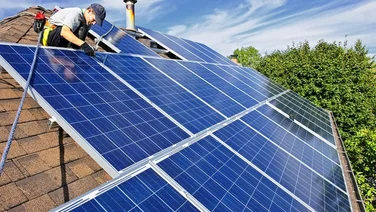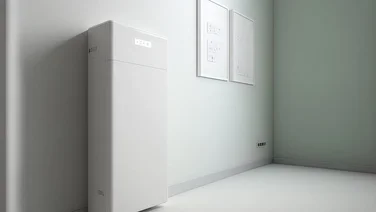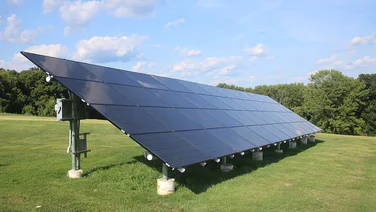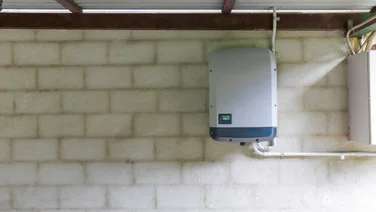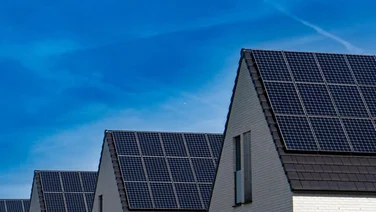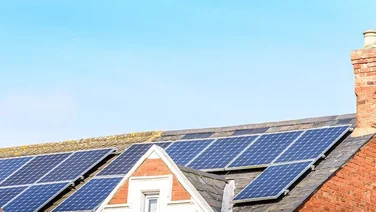- What are solar roof tiles?
- Should I buy solar roof tiles?
- What are the benefits of solar roof tiles?
- How much do solar roof tiles cost?
- How efficient are solar tiles?
- Are solar roof tiles available in the UK?
- Are Tesla roof tiles available in the UK?
- Are solar roof tiles better than ordinary solar panels?
- Summary
- Solar roof tiles work the same as solar panels, but are more discreet
- An average 3.5 kW solar roof tile system will cost you £9,500
- Solar roof tiles have an efficiency rating of between 10% and 23%

Solar energy can reduce energy bills by over 70%, and the UK government is heavily investing in expanding the country’s solar capacity. One type of solar panel, although still somewhat niche, is solar roof tiles, which blend seamlessly with your roof while generating clean electricity.
Solar roof tiles are ideal for those who want the benefits of renewable energy without the traditional look of solar panels. Benefits include, but are not limited to:
- Lower energy bills: Solar panels reduce reliance on grid electricity, significantly cutting monthly energy costs.
- Environmental impact: They generate clean, renewable energy, helping reduce carbon emissions and pollution.
- Energy independence: Solar power can protect against rising energy prices and grid instability.
- Increased property value: Homes with solar panels often sell for a higher price and appeal to eco-conscious buyers.
- Government Incentives: Many regions offer tax credits, rebates, or grants to offset installation costs.
However, because they require re-tiling and come in variations to match different roof types, they are typically more expensive to purchase and install than standard panels.
In this guide, we’ll cover everything you need to know about solar roof tiles — including their efficiency compared to regular panels, how much they cost, where to buy them in the UK, and the top brands to consider.
What are solar roof tiles?
Just like solar panels, solar roof tiles convert sunlight into electricity, but they’re made to look just like traditional roof tiles. Some models are actual roof tiles with integrated solar cells.
Because traditional solar panels are quite bulky and need to be mounted directly on top of your existing roof, some people are put off by their appearance. They can also contrast with the colour and texture of existing roofing materials, such as clay tiles or natural slates. That’s where solar roof tiles come in.
As Chris Hall, director of TBS Specialist Products told The Eco Experts, “wherever you can install a roof tile, you can install a solar tile”.
Solar tiles were invented for people who wanted a more subtle solar-powered home – and are prepared to pay more for these products.
However, unlike solar panels, you can’t just swap out a couple of roofing tiles here or there to install a solar tile roof. You need to replace the whole thing.
For this reason, those considering getting solar roof tiles are often advised to wait until your existing roof is at the end of its life. They are also an excellent choice for anyone building their home from scratch.
Since you’re installing a new roof anyway, why not get one that can repay your investment?

Should I buy solar roof tiles?
If you want to benefit from solar power for your home while preserving the aesthetics of a tiled roof, then yes, you should definitely consider buying solar tiles. Sometimes called ‘invisible solar’, solar tiles are also an excellent option for solar power upgrades to listed buildings or buildings in conservation areas.
They are also fantastic for complex roofs with cross-gables, dormer windows, sloped gables, and other non-standard pitched roofs. In most cases, using solar tiles enables significantly larger solar installations (in terms of area) compared to traditional solar panels.
With more solar tiles entering the market, the current issue is that there are far fewer qualified and experienced installers available than for conventional solar panels.
While this shouldn’t deter you, it is essential to consider the lead time between an installer providing you with a quote and your solar roof tiles being up and operational, particularly if you are considering solar tiles as part of a larger renovation project where timing is critical.
Depending on the make and model, solar tiles come in various colours and materials, with suppliers offering options to suit different roof designs. They are best suited for new home-building projects or for re-tiling roofs that are already in need of repair.
If you have a relatively new roof and are considering switching to solar power, conventional solar panels will likely be more cost-effective. Chris from TBS says that only about 10% of their installs are retrofits for existing homes, with the other 90% for new builds.
You usually won’t need planning permission for solar tiles. Your tiles will not protrude more than 20 cm from your roof, so they’ll almost certainly fall under the ‘permitted development’ category of home improvements.
The only exceptions are if your home is a listed building or in a conservation area.As far as cleaning goes, you won’t need to, unless you live in a particularly dry and dusty environment. The rain will keep solar tiles clean enough to maintain efficient operation, according to most manufacturers.
The one maintenance task you should perform is to keep your solar tiles clear of debris, such as branches or leaves. And if you do feel you need to clean them, you should hose your roof down from the ground.
Do you need solar panels for your home or business?
Generate free, green electricity Reduce your electricity bill by up to 64% Get paid for what you don't use
What are the benefits of solar roof tiles?
- Sleek, subtle appearance – blends with the roof and maintains style
- Little to no glare thanks to mineral coatings, and better low-light performance
- Integrated heat sinks prevent overheating and maintain efficiency
- Prevents birds from nesting behind panels
- Suitable for listed buildings and complex roof forms
- Typically more expensive to buy and install than traditional solar panels
- May still require permission from local authorities for listed or conservation buildings
- Installation requires re-tiling the entire roof
- Efficiency may vary compared to the best traditional solar panels
How much do solar roof tiles cost?
When it comes to cost, a good rule of thumb is that solar roof tile installations are approximately double that of more traditional solar systems. To give you an idea, the average 3.5 kW solar roof tile system will cost around £13,000, compared to approximately £7,000 for a regular PV system.
However, remember that you are also getting a new roof with your solar tiles, so a direct price comparison is slightly misleading.
| House size | Solar PV system size | Cost of solar tiles |
|---|---|---|
One-bedroom flat | 1 kW | £9,000 |
1-2 bedroom house | 2 kW | £10,500 |
3 bedroom house | 3 kW | £13,000 |
4+ bedroom house | 5 kW | £16,000 |
Information last updated in April 2025. Costs courtesy of LD Roofing Services Limited.
When it comes to new roofs, the average cost to replace a roof in the UK is £5,500. If you’re looking at roofing with solar tiles, you could spend anywhere between £3,000 and £18,000.
But the cost is only part of the story. Remember that solar tiles are effectively little solar panels that will generate electricity and eventually pay for themselves from the savings you’ll make on your energy bills.

How efficient are solar tiles?
Solar tiles typically have an efficiency rating of around 10%-23%, making them, on average, less efficient than typical solar panels, which are 18%-25% efficient.
There are cases where solar tiles are much more efficient than panels. The first is shading from trees or buildings, which can temporarily dramatically reduce the overall efficiency of traditional solar panel installations.
This can be an issue for some. Solar tiles require a pitch angle of 14-15 degrees or more, making them unsuitable for flat roofs.
Although solar panels usually have the same limitation because they are typically installed parallel to the existing roof, they can be angled using frames on flat roofs or ground installations. This isn’t possible with solar tiles.
Solar roof tiles can also last up to 30 years, which is the same lifespan as solar panels.
Are solar roof tiles available in the UK?
The available materials are:
- Tyle – Each tile generates 100W and comes with a market-standard product warranty of 10 years and a performance warranty of 25 years
- XO Edge – London-based XO Edge says it can install its sleek-looking black and silver tiles on your roof within eight weeks of purchase. Each tile generates 12W, and you’ll need around 13 tiles per square metre. You need 6.5 square metres of roof tiles per kW of energy generated, which is approximately 84 tiles.
- Marley SolarTile – Each tile generates 335W at an efficiency of 20.7,% and the company offers a 15-year product warranty and a 25-year performance warranty.
- GB-SOL solar tiles – Located in Pontypridd, Wales, GB-SOL solar tiles are lighter than traditional tiles, at 3.5kg per slate, which means you could replace your roof without having to strengthen your property’s structure.
- Solecco Solar – Solecco Solar offers tiles in eight different colours, from smooth grey to terracotta and old English dark red. A 4kW system will cost around £12,000.
- Edilians solar tiles – Edilians make two types of solar tiles, Solar Max and HP 10 Solar. The Solar Max have an aluminium casing and are larger, fitting two per square metre, while the HP 10 have a clay support and fit five per square metre. Both are available in slate or red colours.
- Ergosun – Ergosun Solar Roof Tiles were designed by an engineer in Derbyshire, they are now installed across three continents. They are large-format roof tiles that can have grey or terracotta colour-matched solar PV modules installed, providing the most discreet solar array available.
- Tesla solar tiles – Tesla tiles are extremely tough (up to three times stronger than a traditional roof tile), available in four styles (Textured, Smooth, Slate, or Tuscan), and have an ‘infinite’ warranty. If you want them, you just have to wait a while.
Are Tesla roof tiles available in the UK?
Tesla solar roof tiles aren’t currently available in the UK, and it’s unclear when, if at all, they will be. If Tesla solar roof tiles become available, the company said they will cost $21.85 (£17.23) per square foot. That’s equivalent to $235.12 (£185.37) per square metre.
However, Elon Musk admitted in 2021 that the cost to consumers could be up to three times higher than Tesla’s initial estimate, according to Verge.
Musk is a strong supporter of solar energy for both domestic and commercial purposes and has attempted to make Tesla an integrated energy company through the use of rooftop panels and solar battery systems.
You can find out more about what Musk is doing to improve the environment through our guide: Is Elon Musk good for the planet?
Are solar roof tiles better than ordinary solar panels?
Solar panels, that is solar panels on slate roofs, are still the better investment overall compared to solar roof tiles.
Roof tiles are expensive because you are ultimately installing a new roof, and while they look great, they can be less efficient than solar panels. As we’ve mentioned, solar tiles tend to range between 10% and 20%, although some models approach the best solar panels, topping at around 23%. For comparison, traditional solar panels generally achieve 18-25% efficiency.
How are solar panels attached to the roof? Read our handy guide to find out.
You’re also looking at a longer installation time. This is because replacing a whole roof takes far longer than just sticking on a few solar panels. The average time frame is five-to-seven business days, according to Tesla, but this will vary depending on your personal circumstances.
What’s more, if it’s an existing roof, rather than a new build, the work will include stripping tiles and installing new ones. All of these factors will drive up the cost.
Summary
- Solar energy can cut energy bills by more than 70% and the UK government is investing a large amount financially into improving the UK’s solar capacity
- Solar tiles typically have an efficiency rating of around 10%-23%, making them, on average, less efficient than typical solar panels, which are 18%-25% efficient
- The biggest advantage of solar tiles is their stylish appearance
- As solar roof tiles are a more niche product, available in different variations to match your roof, and installing them means re-tiling your roof, they are more expensive to buy and install than solar panels
- Solar tiles need a pitch angle above 14-15 degrees, so they are unsuitable for flat roofs.


